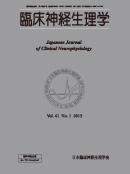Volume 49, Issue 3
Displaying 1-9 of 9 articles from this issue
- |<
- <
- 1
- >
- >|
Original Article
-
2021 Volume 49 Issue 3 Pages 119-123
Published: June 01, 2021
Released on J-STAGE: May 31, 2021
Download PDF (769K)
Case Report
-
2021 Volume 49 Issue 3 Pages 124-130
Published: June 01, 2021
Released on J-STAGE: May 31, 2021
Download PDF (1397K)
Short Communication
-
2021 Volume 49 Issue 3 Pages 131-138
Published: June 01, 2021
Released on J-STAGE: May 31, 2021
Download PDF (1162K)
Special Features
-
2021 Volume 49 Issue 3 Pages 139-140
Published: June 01, 2021
Released on J-STAGE: May 31, 2021
Download PDF (1028K) -
2021 Volume 49 Issue 3 Pages 141-144
Published: June 01, 2021
Released on J-STAGE: May 31, 2021
Download PDF (1386K) -
2021 Volume 49 Issue 3 Pages 145-151
Published: June 01, 2021
Released on J-STAGE: May 31, 2021
Download PDF (1606K) -
2021 Volume 49 Issue 3 Pages 152-157
Published: June 01, 2021
Released on J-STAGE: May 31, 2021
Download PDF (787K) -
2021 Volume 49 Issue 3 Pages 158-161
Published: June 01, 2021
Released on J-STAGE: May 31, 2021
Download PDF (1511K)
Others
-
2021 Volume 49 Issue 3 Pages 162
Published: June 01, 2021
Released on J-STAGE: May 31, 2021
Download PDF (490K)
- |<
- <
- 1
- >
- >|
